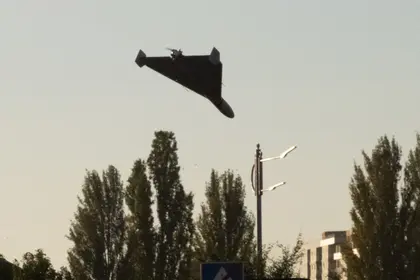Since late 2022, Russia has been using loitering munitions – commonly known as Kamikaze drones – to overwhelm Ukrainian air defenses and attack civilian targets, including energy infrastructure, in a bid to force Ukraine into surrendering.
The most notable drone of them all is perhaps the Iranian-made Shahed-136, used by Russia in its full-scale invasion of Ukraine alongside its domestic variant, Geran-2.
JOIN US ON TELEGRAM
Follow our coverage of the war on the @Kyivpost_official.
Discover a detailed breakdown of drone usage in modern warfare in an earlier Kyiv Post article.
Iranian Shahed-136 Drones
The name "Shahed" comes from the Persian word for witness, testify or testimony. It is one of the five pillars of Islam, which can be seen in the Islamic oath: "I bear witness that there is no deity but God, and I bear witness that Muhammad is the Messenger of God."
Shahed-136 is not to be confused with Shahed-131, an earlier model equipped with a Wankel engine under the Geran-1 designation in Russia's adaptation (and Geran-3 for the gasoline engine variants).
A drone flies over Kyiv during an attack on October 17, 2022. Sergei SUPINSKY / AFP
Background
Developed by an Iranian aerospace company called Shahed Aviation Industries Research Center, the propeller-powered Shahed-136s are relatively cheap to produce compared to more complex variants, such as the Turkish-made Bayraktar TB2 UAVs, whose use by Ukraine garnered media attention at the outset of the invasion.
Due to its portability, the drone can be easily mounted on vehicles and deployed in a range of locations, solving many of Russia’s logistical challenges.

Ukraine Strikes Russian Aircraft Factory, Oil Depot Hit Again, Says Kyiv
The drones also come with a distinctive sound that can be heard kilometers away due to the use of gasoline engines, giving it the nickname of "flying lawnmower" (not to be confused with the more recent makeshift drones deployed by Russia using Chinese components).
Features and capabilities
The Iranian drone uses a delta wing design with improved stability. It is powered by an MD-550 piston engine with a top speed of around 185 kilometers per hour and an estimated range of 1,000 kilometers, roughly the same distance between New York and Michigan.
However, some sources claim it can reach up to 2,500 kilometers. It has a flight ceiling of four kilometers (approximately 13,000 feet).
It has a rocket-assisted takeoff where the pod is jettisoned after launch. The drone is equipped with a 30-50 kilogram warhead at its nose that detonates upon impact.
Using pre-set coordinates, the drone has no remote control and can only attack stationary targets. It is also immune to ordinary anti-drone technology and electronic warfare systems as a result.
Russian-made variants
Iran has repeatedly denied claims of drone supplies to Russia after the invasion began, despite overwhelming evidence that suggests otherwise. According to a Ukrainian government report, the drones were delivered from Iran to Russia through the Caspian Sea.
“From Tehran, the drones are delivered to the Iranian port of Amirabad, from where they are shipped to the Russian port city of Makhachkala,” the report says.
It is known that Russia has been producing its domestic variants under the Geran designation, likely under an agreement with Iran.
According to a report from Conflict Armament Research (CAR), despite the similarities, they were able to determine that Russia began domestic production with improved designs based on their own technology.
According to CAR's investigations, components made in 2023 were also found in recently downed Geran units, verifying the claim that newly produced drones were used in Ukraine – whether they were produced by Iran or Russia.
A police expert holds a fragment of a drone with a handwritten inscription reading "For Belgorod. For Luch" after a drone attack in Kyiv on October 17, 2022 | AFP
European-made components
Recent analyses have discovered Western-made dual-purpose components in downed Shahed units, shedding doubts to the effectiveness of Western sanctions placed on Russia.
According to a report from the Ukrainian government, a fuel pump manufactured in Poland by the German company Ti Automotive GmbH was found in a downed Iranian drone.
Ukraine also discovered an integrated circuit of a buffer network driver and a transistor made by International Rectifier under a German firm, among many other European-made components.
A CAR report referenced earlier also confirmed the use of Western components: "The Geran-2 UAVs documented by CAR investigators in Ukraine are almost exclusively made of components bearing marks of companies based outside the Russian Federation."
The Use of Shahed Drones in Ukraine
Shahed-136s have seen increased usage since late 2022, and they have been used by Russian forces to attack energy infrastructures throughout Ukraine in the winter to deprive civilians of electricity, a move criticized by EU Commission President Ursula von der Leyen as "war crimes" and "pure terror."
Communal workers repair power lines cut by shelling in the Saltivka district, northern Kharkiv, on May 15, 2022. Dimitar DILKOFF / AFP
Russia has been using loitering munitions in combination with conventional missiles to overwhelm Ukrainian air defenses. While a Kalibr missile – commonly used by Russia for precision strikes – costs close to $1 million, a Shahed drone only costs up to $50,000.
Ukraine reportedly shot down more than 300 Iranian-made drones in 2022, and the total is now estimated to be much higher.
"It is necessary to fight against drones because this autumn/winter will be a record in the number of Shahed UAVs," said Yury Ihnat, a spokesperson for the Ukrainian Air Force.
You can also highlight the text and press Ctrl + Enter













